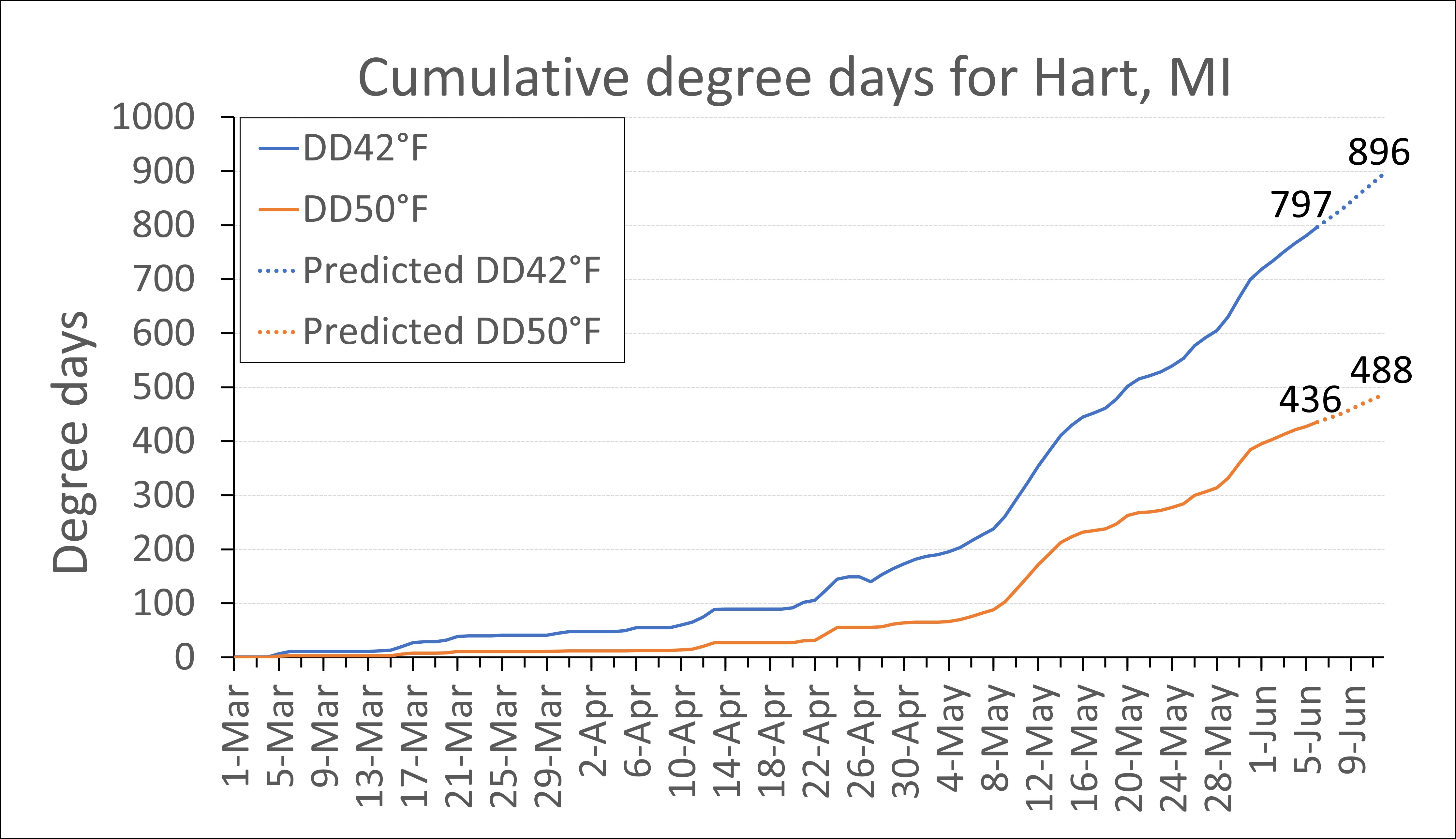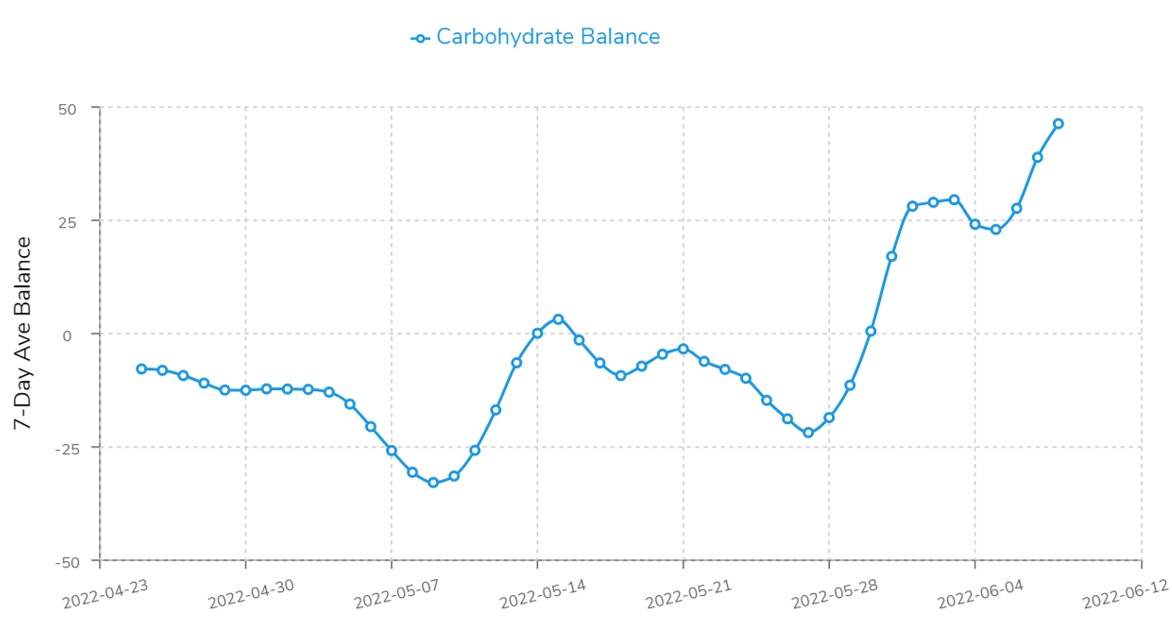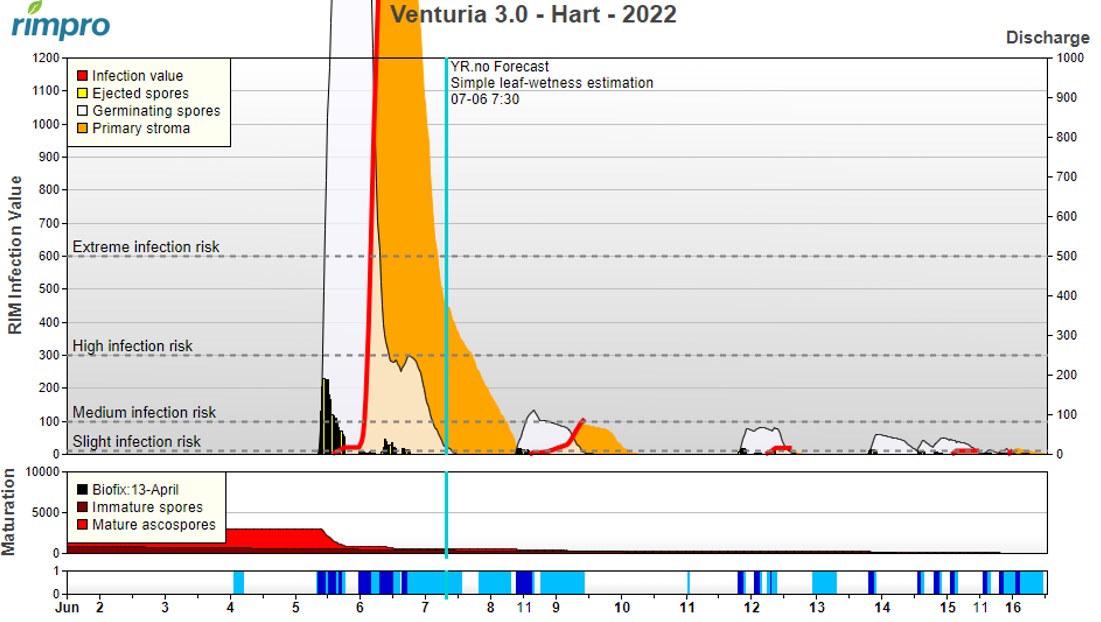West central Michigan tree fruit update – June 7, 2022
Cool temperatures have slowed fruit growth and insect activity this week.

Weather update
Warm weather over the weekend and early this week has led to steady fruitlet growth (Figure 1). Based on the Hart weather station for June 6, current DD accumulation is 804 DD42 and 445 DD50 (Figure 2). Accumulation of DD has increased by 101 DD42 and 55 DD50 over the past week. Across the region, DD accumulation has been slow due to the cool weather and is currently behind the 5-yr average (Table 1).
Cool and cloudy weather will continue this week with high temperatures in the upper 60s and low 70s and low temperatures in the upper 40s and low 50s. Rain is also forecasted for Wednesday, June 8. Temperatures have been cooler than normal, but are forecasted to warm up early next week on June 13 – 14 according to Jeff Andresen, Michigan State University. Watch Andresen’s current weather report.

|
Table 1. Current and 5-year average DD summary from Jan 1- June 6. Numerical integration was used for degree day calculations. |
||||
|
Station |
2022 DD Base 42°F |
5-yr Avg DD Base 42°F |
2022 DD Base 50°F |
5-yr Avg DD Base 50°F |
|
Benona/Shelby |
741 |
838 |
393 |
442 |
|
Elbridge/Hart |
803 |
907 |
452 |
508 |
|
Fremont |
866 |
979 |
492 |
558 |
|
Grant* |
876 |
991 |
494 |
561 |
|
Hart |
804 |
904 |
445 |
498 |
|
Ludington |
780 |
880 |
432 |
484 |
|
Mears** |
812 |
914 |
450 |
504 |
|
New Era** |
805 |
907 |
441 |
496 |
*Averages were calculated using data from 2020-2021.
**Averages were calculated using data from 2018-2021.
Rain events occurred on June 5 and 6 across the region (Table 2). Total rainfall is below the 5-year average in most locations, so recent storms brought much needed rain. However, since the region is below average for rainfall and some locations received less than ¼ in of rain, some orchards may need irrigation this week, particularly for new plantings or young orchards.
|
Table 2. Rainfall totals from rain events on June 5 and 6, total rainfall from Jan. 1 – June 6, and the 5-year average rainfall for Enviroweather stations in West Central, MI. |
|||
|
Station |
Rainfall (in) |
Total rainfall (in) |
5-year Average (in) |
|
Benona/Shelby |
0.51 |
9.88 |
11.07 |
|
Elbridge / Hart |
0.36 |
10.7 |
13.03 |
|
Fremont |
0.21 |
10.9 |
12.14 |
|
Grant* |
0.14 |
12.7 |
13.46 |
|
Hart |
0.45 |
9.8 |
10.99 |
|
Ludington |
0.36 |
8.8 |
11.34 |
|
Mears** |
0.47 |
9.99 |
10.46 |
|
New Era** |
0.26 |
9.55 |
10.07 |
Weather data was gathered from MSU Enviroweather.
More information and reports on normal weather conditions and departures from normal can be found on the NOAA Climate Prediction Center website, NOAA U.S. Climate Normals website, NOAA Climate Normals Quick Access Page (which may be searched by region) and Midwest Regional Climate Center website.
Crop update
Even with cool temperatures, fruitlets have steadily grown. Many growers have put on first cover sprays to target active pests and to continue disease management for apple scab and cherry leaf spot. Apple growers also took advantage of warmer temperatures over the weekend to apply additional chemical thinners if needed. Effects of thinning applications can be evaluated later this week. For growers interested in monitoring fruitlet growth to determine if additional thinning applications are needed, growers can use the fruitlet growth model. Here is a link to an MSU Extension video and article that explains the Fruit Growth Rate Model that is available on the Malusim app. Fruit set should be more evident toward the end of the week, and growers should decide if a final thinning spray should be used or if hand thinning will be needed. Growers will also need to evaluate the need for peach thinning.
Apple varieties in the West Central region are being monitored, and fruitlet diameter is being has increased by 2-4 mm over the past 4 days for most varieties. In Oceana County, fruitlet diameters of many varieties, such as Gala and Honeycrisp, range from 17 - 20 mm. Jonagold fruitlet diameters range from 15 - 22 mm. Growers are advised to consider if another thinner application will be needed. For Hart, Michigan, the NEWA Cornell Apple Carbohydrate Thinning Model is predicting a carbon surplus for June 7 and 8 (Figure 3), and the model recommends a 30% increase in chemical thinning rate. Cooler temperatures later this week may limit efficacy of thinners.

For more thinning recommendations, access the 2022 Thinning Guide.
For specific information on thinning strategies for Honeycrisp in 2022, check out this article from MSU Extension specialist Anna Wallis, “Honeycrisp Crop Management for 2022.”
Tart and sweet cherry fruit diameters range from 10 - 15 mm.
Peach fruit are sizing well. In Oceana County, fruit diameters range from 10 - 14 mm.
Pear fruit diameters range from 12 - 16 mm.
Pest and disease update
In the west central region, growers should continue scouting blocks to target hot spots for active pests in the orchard according to growth stage. Cooler weather has slowed pest activity and flight for some insects. Growers should remain vigilant to protect against cherry leaf spot, apple scab, and powdery mildew given the rain and warmer temperatures this week. Fire blight symptoms may be present if infection from blossom blight occurred. Growers should begin scouting orchards to monitor for fire blight symptoms.
Current pests
American plum borer has been observed in the region. This week, an average of 0.5 adults/trap was observed. Our tools to manage American plum borer are limited with the loss of Lorsban (chlorpyrifos). Growers should continue to monitor borer populations. American plum borers are attracted to wounded trees, and wounds allow easy entry for borers into the tree cambium tissue. Growers are encouraged to minimize tree stress and wounding when possible.
Codling moth biofix is predicted to have occurred on May 14. Sustained trap catch has occurred, and the start of first generation egg laying was predicted for May 26. First egg hatch is expected today, June 7. No codling moths were trapped at an orchard in Oceana County this week.
European red mite was observed this week. Warm and dry conditions are favorable for larvae activity so cool and rainy conditions are likely slowing down mite development. The recommended treatment threshold for European red mites is five to seven mites per leaf through July.
Greater peach tree borer (peach tree borer) has not yet been trapped in the region. Management for borers is limited this year with the loss of Lorsban (chlorpyrifos), but mating disruption is recommended for greater and lesser peach tree borer in orchards with at least 5 acres and trees that are at least 3 years old.
Lesser apple worm was observed in low numbers this week. Only 1 adult was found in a trap at an orchard in Oceana County. Lesser apple worm larvae feed on small fruit or can borer into succulent shoot terminal this time of year. Growers should apply sprays that target adults before egg lay occurs.
Lesser peach tree borer has been observed in the region with an average of 10.5 borers/trap in Oceana County. Similar to greater peach tree borer, mating disruption is recommended for lesser peach tree borer in orchards with at least 5 acres and trees that are at least 3 years old.
Obliquebanded Leafroller biofix is estimated to be June 13 for the Hart area. Sustained catch is expected at 900 DD42. No obliquebanded leafrollers were trapped this week in Oceana County, but an average of 2 adults per trap were counted at the Trevor Nichols Research Center in Fennville, MI. Scout orchard blocks in the coming week to determine if a spray is needed.
Oriental fruit moth biofix 1 is estimated to have occurred on May 9. Sustained trap catch has occurred, and first egg lay occurred on May 11. Peak egg laying was predicted for May 30. Only 2 OFM were trapped at 1 location in Oceana County this week.
Pear psylla adults and newly laid eggs were found in the region. Early management is key to keeping damage thresholds low through the season.
Plum curculio damage was observed this week in apples and cherries. Growers should continue to monitor their orchards for damage, especially in areas that border wood lots.
Redbanded Leafroller adult flight is still low in the region. Continue to monitor this minor tree fruit pest.
Rosy apple aphid is a common pest in our region. Growers can scout for colonies of dark purple nymphs in fruit clusters and treat blocks as needed.
San Jose scale is present in some orchards in the region. An average of 0.7 San Hose scale were trapped at the Trevor Nichols Research Center this week. Flight is still very low. For infested trees, targeted sprays or oils can be used to manage scale and target adults. Growers should monitor in blocks where scale were present on fruit in 2021. San Jose scale may feed on apple, pear, plum, apricot, and sweet cherry.
Spotted tentiform leafminer activity may be lower this week because of cooler temperatures. Adults have been trapped in low numbers in the region. Larvae that feed on sap of leaves may be present shortly.
Disease update
Apple scab: RIMPro forecast is predicting a medium infection risk for apple scab infection on June 8-9 (Figure 4). Wettings events are predicted to start late on June 7 with continue rain showers on June 8-9. Spores continue to mature, and another spore release is expected with upcoming wetting events this week. Spore counts from the June 5/6 wetting event were 50 spores/rod. Even though spore numbers are declining, we are still in primary scab season, so infection can occur.

Powdery mildew: Warm temperatures and high humidity to come early next week may result in powdery mildew infection. Powdery mildew causes infections on the underside of the leaf that lead to chlorotic patches or spots on the upper side of the leaf. Growers should continue to spray for powdery mildew through midsummer.
Cherry leaf spot: Wetting events this week may lead to infection periods for the cherry leaf spot fungus, Blumeriella jaapii. Disease pressure was high in 2021 in west central Michigan, and maintaining coverage of new tissue will be critical this season. Cherry leaf spot should be managed in both bearing and non-bearing orchards. No evidence of cherry leaf spot infection has been found yet from previous infection periods.
Fire blight: Some apple varieties may still have open blossoms across the region. It is important for growers to keep blossoms protected from fire blight if they open. If bloom is over, growers should focus on minimizing shoot blight and the development of cankers that overwinter. Growers are encouraged to scout for symptoms of shoot blight and continue management with an Apogee and Actigard program.
For pest and disease management recommendations, please refer to the E-154 for product guidelines.
For more information about regional reports, please visit the Michigan State University Extension webpage.



 Print
Print Email
Email




